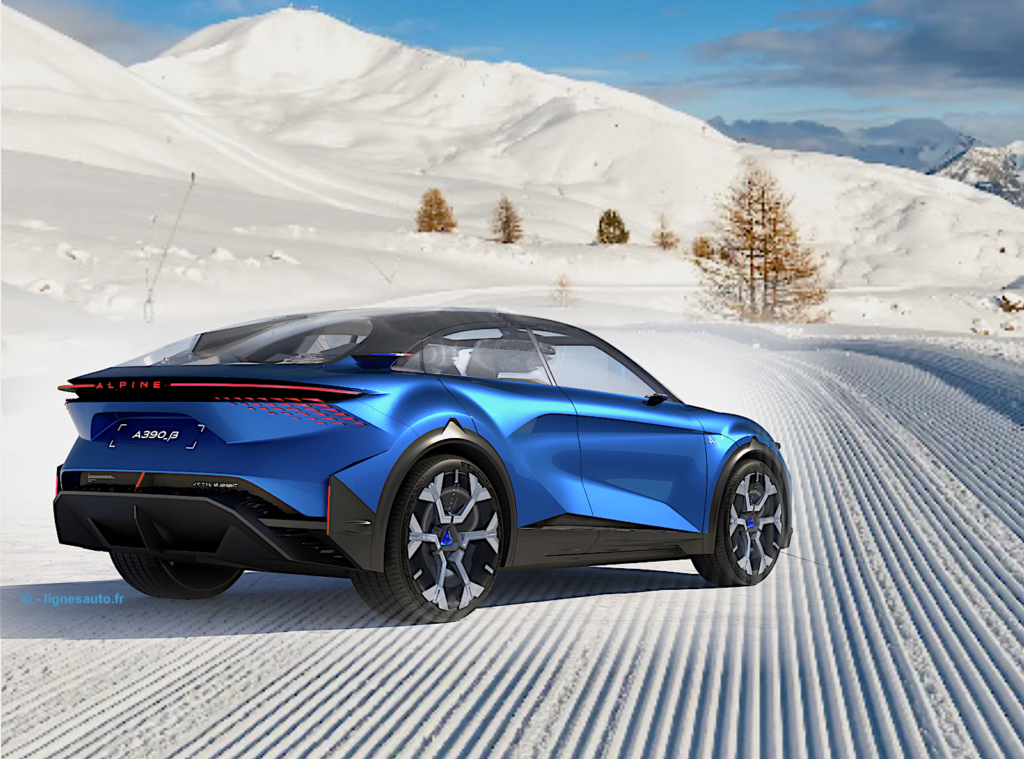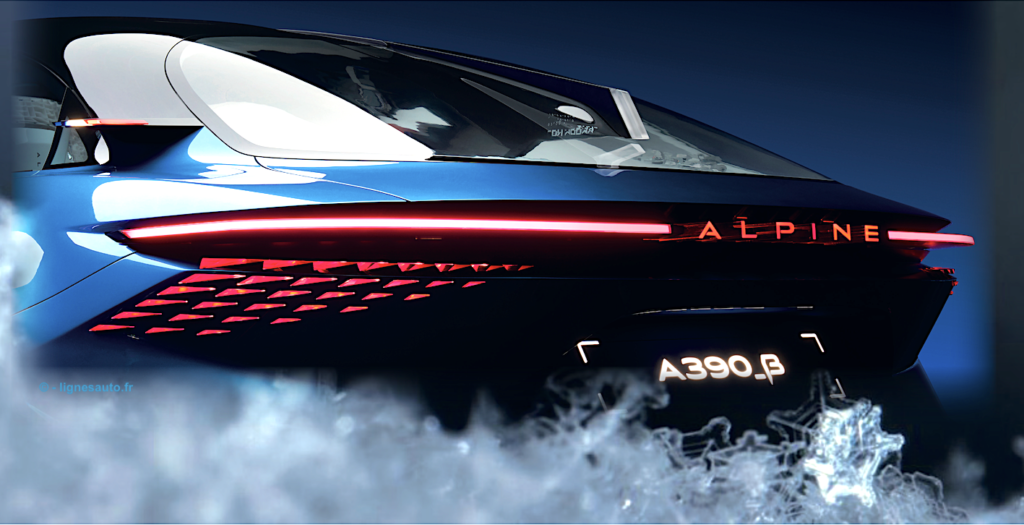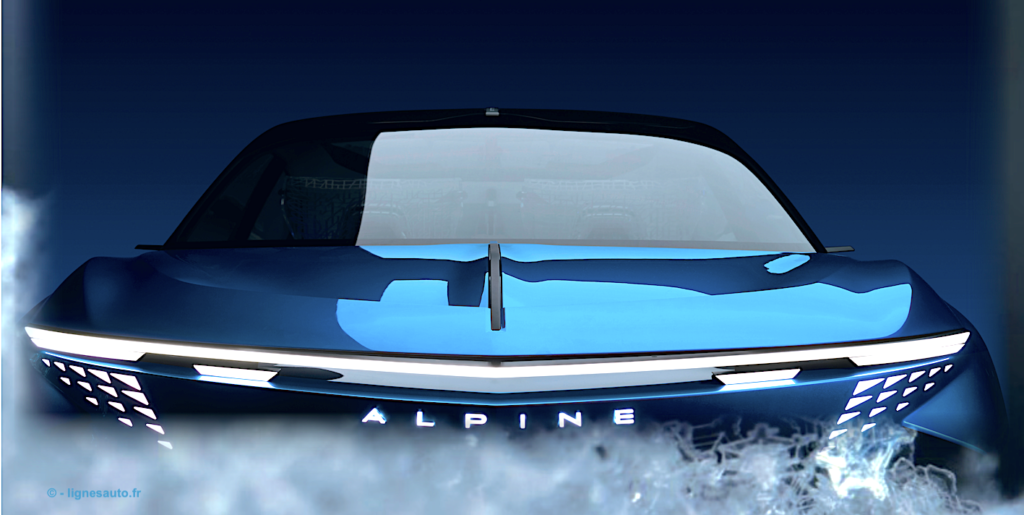
This is it! Alpine has unveiled 85% of its future 5-seater sports crossover, which will go on sale in 2025. The A390 of tomorrow appears in this concept car, with an exterior almost identical to the future production model, and a forward-looking interior in which, as one of the designers writes on board, ‘ nothing is symmetrical!

Sporty, we ask? The manufacturer says so, explaining that the production A390 is ‘ designed for everyday use, but is capable of being transformed into a racing beast like the iconic A110 ’.

The A110, like a Phoenix shaking the embers of its rebirth in 2017, has since carved out a fine reputation. But it’s now entering the home straight, the end of its life, before being renewed in 2027 with two all-electric variants: a coupé and a cabriolet. It will inaugurate the new APP platform which will officially be inherited by the future 4-seater A310 (longer, below) in 2028.

In 1968, I was seven years old and one of my father’s friends drove a yellow A110. All I remember about it is the smell of glue, and I didn’t think it smelled as good as the almond glue in my schoolbag. I thought the A110 was a giant, roomy car, and it was only much later that I realised that it was my childish eyes that thought it was ‘giant’. Because the A110 is a tiny two-seater that will perpetuate the myth for eternity when it arrives with its – or its? – electric motor(s) in 2027.

Yes, we have to stop denying it: Alpine will only produce electric cars with the future A110, A310 and the next A390, most of which is unveiled here. In 2021, with the Renaulution, Luca de Meo’s speech was well understood. To everyone’s surprise, Alpine landed on the podium of the Group’s three brands, alongside Renault and Dacia. But the counterpart was to anchor Alpine in a future that we can still imagine today as 100% electric.

For Renault and Dacia, this maxim is not the only one, since it coexists with hybridisation, and for Alpine, the product plan is moving at high speed towards all-electricity… but behind the scenes it does not overlook a possible internal combustion engine powered by hydrogen. The production A390 is based on the AmpR Medium platform used in the Scénic and Megane, but has been ‘ extensively reworked ’, according to the manufacturer.

What about the design of this A390? Don’t call it an SUV, because it’s not. In terms of architecture, it’s far from it. Rather than calling it a crossover, Alpine has chosen to call it a Sport Fastback. SF, as in Science Fiction. But this is almost reality. And in the end, we are very impressed by the ability of the designers – led by Antony Villain – to integrate some of the A110’s codes into the design of this “great” 5-seater sports car. And don’t bark at those who think – and they have every right to do so – that ‘ the A390 has nothing to do with a real Alpine ’: without it and its future products, the brand could not survive.

The A110’s design cues are most evident at the rear, between the flanks and the start of the boot lid curves. The whole is supported by a very dynamic C-pillar above the rear wheel arch. Don’t put words in my mouth: the A390 is not a big A110. That’s not its role. But the unprecedented task of creating a new Alpine ‘family sports car’ was not a foregone conclusion. At LIGNES/auto, we really like it because it’s refreshing!

The Alpine brand was named by Jean Rédélé in honour of the Alps, and snow and snowflakes serve as a common thread running through the exterior and interior design. An obvious feature of the A390’s volume is that its upper cabin area is treated like a glass bubble, above. With so much light, you’d think you were inside a snow globe, ready to gaze at the mountains. Don’t shake me too much, I’ve got a text to finish…

Although we still don’t know how the production vehicle will be treated in this respect, the solution of this upper bubble literally puts the machine on its wheels, with a blue body mass – the new Secular Blue colour – that appears lighter all of a sudden. No, the A390 is not an SUV.

The rear of the car above features a light signature incorporating three elements: a band interspersed with the Alpine name, around thirty triangular light points on either side of the bumper (Alpine calls them Cosmic Dust) and finally, aerodynamic elements that are also finely illuminated.

The lower spoiler above can be extended backwards by eight centimetres, taking the light bar with it. This principle is immediately reminiscent of the 2020 Renault Morphoz concept car below, designed by the team of François Leboine, now head of Fiat design.

But while in the latter case the lengthening benefited habitability, in the case of the Alpine it is primarily a question of improving aerodynamics and gaining a few kilometres of range. In this way, Alpine is maximising the ‘aerobladder’ concept seen on the Opel Flextreme GT/E concept from 2010 and the Renault Eolab from 2014, among others.

From the front, the change in brand identity is radical. Gone are the (almost) round headlamps, replaced by the light signature unveiled by the Alpenglow concept car. An illuminated transverse blade overhangs four extremely slender headlights, all integrated into a light black mask, while just below the headlights we find the famous cosmic dust and, in the centre, the illuminated Alpine name.

The sides are solidly embossed with sharp, clean edges that impose a hollowed-out movement in the doors, subtly treated. It diffuses light in a highly sophisticated way right down to the muscular wheel arches. If the bodywork is that of the production vehicle, I wish the embossers a Merry Christmas. I have a soft spot for stamping specialists, those men and women behind the scenes who tear their hair out as soon as they get close to a Clay model created by the designers, which is often far-fetched (the model, not the designers, although sometimes…). We salute them…

Let’s move on to a subject we’ve been wondering about: the famous ‘Flying Bridge’. What does it mean? These are the air intakes that run under the top of the bonnet – at the front – to improve airflow. You can see it clearly below. The same principle can be found on the Renault Emblem prototype, which will be presented just a few metres from the A390-B, from Tuesday 15 October at the Paris Motor Show.

We know that in the secrecy of the Renault group’s modelling workshop, in the basement of the design building at Guyancourt (78), there are no partitions and the group’s various design bosses (Antony Villain for Alpine, Gilles Vidal for Renault, David Durand for Dacia and Jean-Philippe Salar for Mobilize) can see what the ‘competing’ teams are doing. Strange, then, to see an identical solution appearing at the same time on two concepts from the same group…

‘But Mr Bonnaud, this flying bridge is simply one of the formulae in vogue to improve aerodynamics. So it’s perfectly in line with the design of our future 100% electric models ’, says a little voice from Guyancourt… And to think that in my wildest flights of fancy, I had imagined that the Renault Emblem above was derived from an Alpine crossover whose programme was abandoned. I need to stop drinking green tea.

Let’s take advantage of a snowstorm to shelter on board. There’s nothing here to foreshadow the production vehicle. It’s a repeat of the A290-β concept car! So the interior design team had a field day, and here again, it’s a refreshing change. ‘ If you do it right, it’s right; if you do it old, it’s old; if you do it modern, it’s modern,’ is written in black and white on a plaque on board the A390-β.

Antony Villain explains that ‘the coloured exterior contrasts with the monochrome interior, where the sharp black mineral contrasts with the whiteness of the immaculate snow’. Immaculate snow in design, then. ‘Technology coexists with nature, the raw with the refined, the hot with the cold…”

‘The driving position itself has two faces: with a simple press of the central control, it transforms into a Formula 1 cockpit,’ adds Antony. And that’s thanks to a dual driving position coupled with a change in the geometry of the steering wheel and a shift in the pedals.


And yes, tomorrow’s A390 won’t spend its days ferrying children home from the sports club. No, there will be a pilot on board. At the front, we discover a highly technological atmosphere supported by a mineral skin.

At the rear of the car, the opposite is true: you’re resting in a thick carpet of powder snow. This contrast of two different worlds in the passenger compartment is nothing new in itself, but it’s striking here because it’s worked out down to the smallest detail. And in these details, I’ve found plenty of devils who say to themselves that this concept ‘is the stuffof apples!

The first version of the A390 will have two electric motors on the rear axle and a third at the front. All this is managed by the Active Torque Vectoring system, which controls the distribution of torque between the front and rear axles, with the addition of independent control of the torque on the left rear wheel in relation to the right, which obviously improves dynamism in the bends below. ‘ It’s a balancing act ’, we’re told, “ that gives the vehicle the A110”s feeling of lightness ’. So, is the Alpine A390 an SUV?

An Alpine assembled in Dieppe
As the manufacturer proudly announces, the 100% electric Alpine will be 100% French. ‘The production version of the A390 will be manufactured from 2025 at the Manufacture Alpine Dieppe Jean Rédélé, based on the AmpR Medium platform. Its three electric motors will come from the Megafactory in Cléon and the batteries will then be assembled in Douai, confirming the short circuit manufacturing of the future A390.’

